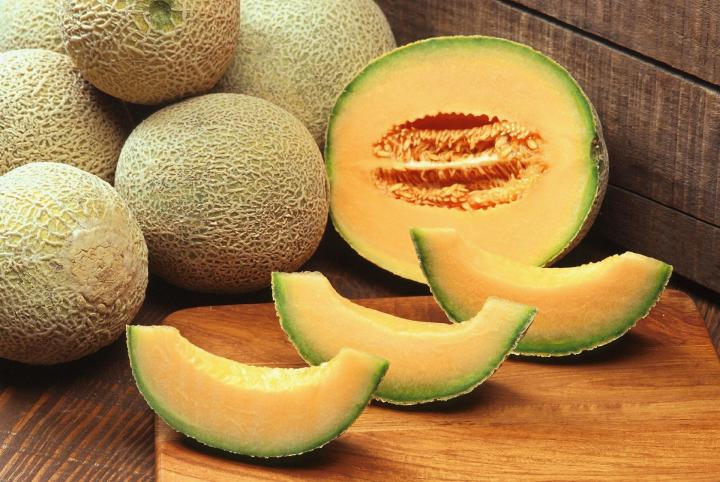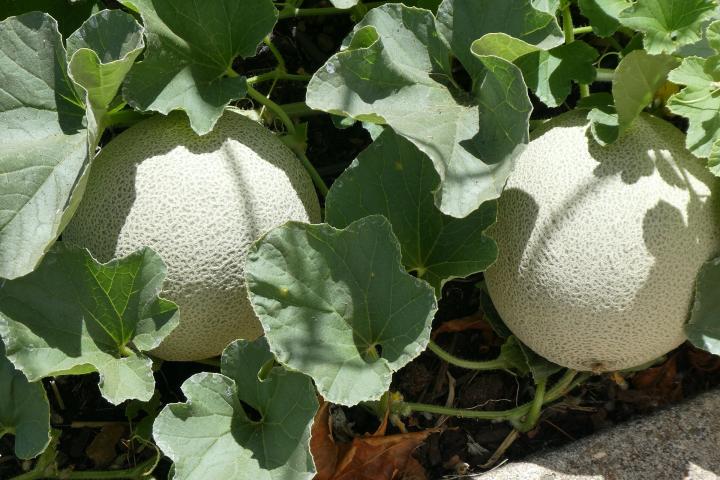Cantaloupes are a delicious, heat-loving melon with a relatively long growing season, making them especially well-suited for southern gardeners. Here’s how to grow cantaloupes in your garden!
What Is a Cantaloupe?
Cantaloupes are a type of melon with a tan-green rind. Typically, the rind is covered in a spiderweb-like pattern, though some varieties may also be striped. Inside, the flesh is bright orange and sweet. Their growing requirements are similar to that of other popular melons, such as watermelons and honeydew melons.
Cantaloupes vs. Muskmelons
Oddly enough, the melon that is commonly referred to as a “cantaloupe” in North America is not actually a true cantaloupe, which are more common in Europe. In fact, our “cantaloupes” are a type of muskmelon. (True cantaloupe has a rough, warty rind and is not widely grown or commercially available in the US and Canada.)
In North America, the names “muskmelon” and “cantaloupe” are used interchangeably, but we will refer to this fruit simply as “cantaloupe” on this page to avoid confusion!

When to Plant Cantaloupes
- Cantaloupes may be started from seed or purchased as young plants. In colder regions, starting with young plants is recommended, as it will give you a head start on the growing season.
- To start from seed:
- If you are in a colder region, start seeds indoors 4 to 6 weeks before your last spring frost date. Cantaloupe vines are very tender and should not be transplanted until all danger of frost has passed and soil temperatures remain above 60°F (16°C).
- If you live in a warmer climate, you may direct sow seeds outdoors as soon as the soil temperature warms to at least 60°F (16°C).
Choosing and Preparing a Planting Site
- Cantaloupes do best in well-draining soil that’s a mix between loamy and sandy.
- Plant in a spot that gets full sun. To produce the best melons, the plants need all the light they can get. Plus, afternoon sun will dry off leaves, reducing the risk of fungal and other diseases that come with wet foliage.
- Growing the plants in raised rows—aka “hills”—ensures good drainage.
- Amend soil with aged manure or compost before planting. (Learn more about soil amendments and preparing soil for planting.)
- Mulching the planting site with black plastic will serve multiple purposes: it will warm the soil ahead of planting, hinder weed growth, and keep developing fruits clean.
How to Plant Cantaloupes
- Plant seeds 1 inch deep, 18 inches apart, in hills (or hilled rows) about 3 feet apart.
- If you have limited space, vines can be trained up a support, such as a trellis.

How to Grow Cantaloupes
- If a soil test indicates that nutrients are lacking, fertilize with a standard liquid fertilizer when vines start growing and spreading. Later on, avoid nitrogen-heavy fertilizers, as too much nitrogen can result in lots of foliage and less fruit.
- Row covers are a good way to keep pests like squash bugs and vine borers at bay.
- Watering is key. While the plants are growing, blooming, and setting fruit, they need 1 to 2 inches per square foot of water (about 1.5 gallons) per week.
- Water in the morning, and try to avoid wetting the leaves, as wet foliage encourages fungal and other diseases.
- If possible, use drip irrigation to keep plants consistently and evenly watered.
- Mulching around the plants can help to retain moisture.
- Reduce watering once fruits are growing. Hot, dry weather produces the sweetest melons.
- If you’ve had an exceptional amount of rainfall during the ripening stage, this can cause bland fruit.
- Once fruit begins to grow, prune end buds off vines. Your plants may produce fewer melons, but they will be larger and of better quality.
- Vines produce male and female flowers separately on the same plant. They often begin producing male flowers several weeks before the females appear. (Don’t be discouraged when the first blooms do not produce fruit.)
- As with other cucurbits, melon flowers require pollination to set fruit, so be kind to the bees! Here’s how to pollinate flowers yourself to increase yields (squash flowers are shown as an example, but the principle is the same for melons).
- If your muskmelons taste bland, the trouble could be a lack of magnesium in sandy soil. Sweeten the fruit by spraying the vines with this solution: Dissolve 6 1/2 tablespoons of Epsom salts and 3 1/3 tablespoons of borax in 5 gallons of water. Spray the foliage when the vines begin to “run” and again when the fruit is about two inches in diameter.
- Aphids
- Cucumber Beetles
- Squash Vine Borer Moths
- Fusarium Wilt
- Powdery Mildew
- ‘Ambrosia’ — 85 days to maturity. Among the sweetest varieties.
- ‘Athena’ — 70-80 days to maturity. Early variety that produces large, 5-6 pound fruits.
- ‘Hale’s Best Jumbo’ — 80-90 days to maturity. Produces 3-pound, aromatic melons.
- ‘Minnesota Midget’ — 70-80 days to maturity. Early variety well-suited for gardens in colder regions. Produces 1-pound, sweetly flavored melons.
- ‘Bush Star’ — 90 days to maturity. Bush variety suits gardeners with limited space.
How and When to Harvest Cantaloupes
- When rinds begin to change from green to tan or yellow, the melon is typically ripe enough to pick. Be careful not to pick too early, however.
- Look for a crack in the stem where it attaches to the fruit. This is a sign of ripeness as well. The fruit should be easy to separate from the vine, but if they fall off by themselves they are usually overripe.
- Harvest melon when vines are dry, and be careful not to damage them.
- Melons will soften after harvesting, but will not continue to sweeten off the vine.
- Cantaloupe can be stored uncut for 5 or 6 days. If cut, they can last in the refrigerator for about 3 days, wrapped tightly in plastic.
- Cantaloupe was named for Cantalupo, a former papal villa near Rome.




